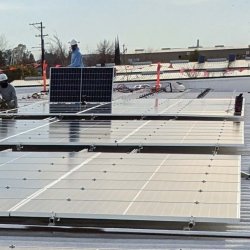Welcome to this new blog series by our own Shyla Black, Multi-family & Commercial Solar Program Coordinator, diving into the impact of GRID’s work for renters in multifamily developments and nonprofit organizations.
Lately, I find myself doing a lot of daydreaming about the future. I envision a movement toward self-reliant communities. I want my life's work to be a part of a greater effort where each person knows, feels, and sees that their work is important. I don’t mean paid work specifically, but rather our work as the energy that we put into our homes, our neighborhoods, and our regions in terms of care, volunteering, speaking up and acting as witnesses to injustice, and so forth.
In many ways we see this happening with the rise of mutual-aid efforts, groups of citizens coming together without formal organization to help each other with food, clothing, shelter, and even money. These mutual-aid efforts have been increasingly popping up in the wake of recent large disasters and have gained momentum since the shelter-in-place ordinances for COVID-19.
Despite the darkness of police brutality against black and brown communities, the deaths from COVID, and the uptick of violence against people of Asian descent, I have witnessed inspiring and motivating actions as well. People have been holding each other up by giving away part or all of their stimulus checks, donating to funds that go directly to food industry workers in their communities. They are donating to keep human rights campaigns going, to help raise funds to pay bail for people incarcerated by the US Immigration and Customs Enforcement (ICE). People are looking out their windows at what is happening around them and acting. People have STEPPED UP.
These actions help me see the potential for self-reliant and resilient communities.
As the Multi-Family and Commercial Solar Program Coordinator with GRID Alternatives North Valley, working to connect tenants, developers, and nonprofits with solar, I have had the privilege of collaborating with amazing people who are keeping food banks running despite the major spikes in community needs, lack of volunteers and staff; and not enough hours in the day. From this experience, I have come away with a profound appreciation for just how much solar assists people and communities. I see self-reliance as a web consisting of everyone's efforts. We depend on each other, we need each other, we need community. We need renewable energy that supports interconnection, our work, our pockets, and funding sources. We need solar systems to power the community service providers, nonprofits, emergency services, which function as an integral part of the communal web that we rely on for our health care,, our family care, and our survival.
Back in May we wrote about our partnership with SMUD which allowed us to install a solar photovoltaic system at the Sacramento Food Bank, and how it would save them $185k over the life of that system. They are now able to distribute those savings to other areas of programming, such as their clothing program where people can shop for free, with dignity, in order to be outfitted for a job interview.
This spring we also installed a system for the North State Food Bank, run by the Community Action Agency of Butte County. The North State Food Bank is expected to save $42,000 a year with its new PV system. That amounts to a living wage for an entry-level staff person. It is a new program to support outreach efforts in the many regions they serve. I see it as self-reliant funding that has no strings attached. It is one nonprofit (GRID) supporting another nonprofit. The same way one neighbor supports another through mutual aid. That, to me, is resiliency and community self-reliance.
For more information on receiving solar for your food bank or non-profit building with GRID, email me, Shyla Black, at sblack@gridalternatives.org and we can set up a time to talk about your options.

